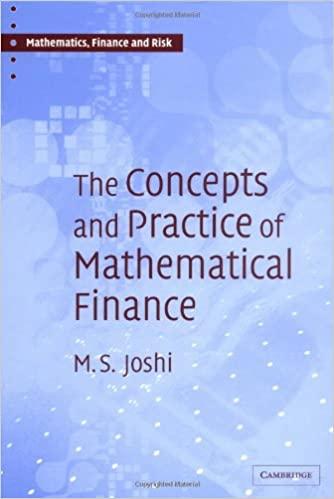
Incomplete Markets. Consider an economy that encompasses only two possible states of the world and two assets. The following information is available about the payoffs of the assets in the different states and the market prices. Asset B State 1 State 2 Price Asset A 1 2 15 Asset A can be interpreted as a stock, while asset B represents a risk-free instrument. Compute the prices 1 and 2 of the elementary state securities in this market. Introduce a new financial instrument in this market, which we denote as asset C. This instrument constitutes a European call option on asset A with strike price K = 1). What are the payoffs of asset C in the two states? Compute the price of asset C that preserves the arbitrage-freeness of the market. A careful analysis of the economic environment has shown that there is a third possible state of the world, which has a small but nonzero occurrence probability. The payoffs of the assets A and B in state 3 are given by d = 3 and d = 1, respectively. The payoffs in states 1 and 2 and the prices of the assets A and B remain unchanged. In a three-state economy with two assets the prices of the elementary state securities are no longer unique. Describe the set of all nonnegative state prices 41. 42 and 43 that are consistent with the known prices of the assets A and B. Determine the projection of this set into the (41.42-plane and compare it with the state prices computed in part a. Consider the three-state economy from partc and introduce again asset C, that is, a European call option on asset A with strike price K= 13. Compute the payoffs of asset C in the three states. In the three-state economy, the arbitrage-free price of asset C is no longer unique. Compute the interval of prices of asset C for which the market remains arbitrage-free. Incomplete Markets. Consider an economy that encompasses only two possible states of the world and two assets. The following information is available about the payoffs of the assets in the different states and the market prices. Asset B State 1 State 2 Price Asset A 1 2 15 Asset A can be interpreted as a stock, while asset B represents a risk-free instrument. Compute the prices 1 and 2 of the elementary state securities in this market. Introduce a new financial instrument in this market, which we denote as asset C. This instrument constitutes a European call option on asset A with strike price K = 1). What are the payoffs of asset C in the two states? Compute the price of asset C that preserves the arbitrage-freeness of the market. A careful analysis of the economic environment has shown that there is a third possible state of the world, which has a small but nonzero occurrence probability. The payoffs of the assets A and B in state 3 are given by d = 3 and d = 1, respectively. The payoffs in states 1 and 2 and the prices of the assets A and B remain unchanged. In a three-state economy with two assets the prices of the elementary state securities are no longer unique. Describe the set of all nonnegative state prices 41. 42 and 43 that are consistent with the known prices of the assets A and B. Determine the projection of this set into the (41.42-plane and compare it with the state prices computed in part a. Consider the three-state economy from partc and introduce again asset C, that is, a European call option on asset A with strike price K= 13. Compute the payoffs of asset C in the three states. In the three-state economy, the arbitrage-free price of asset C is no longer unique. Compute the interval of prices of asset C for which the market remains arbitrage-free







